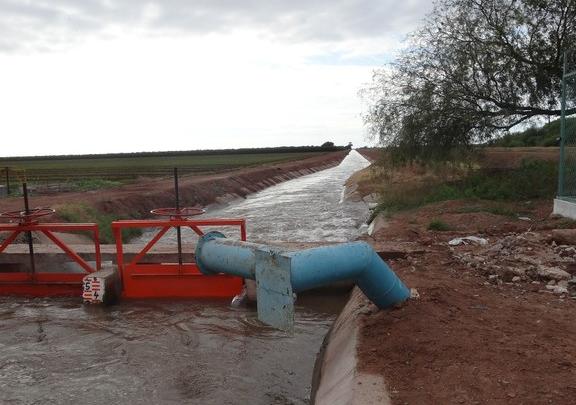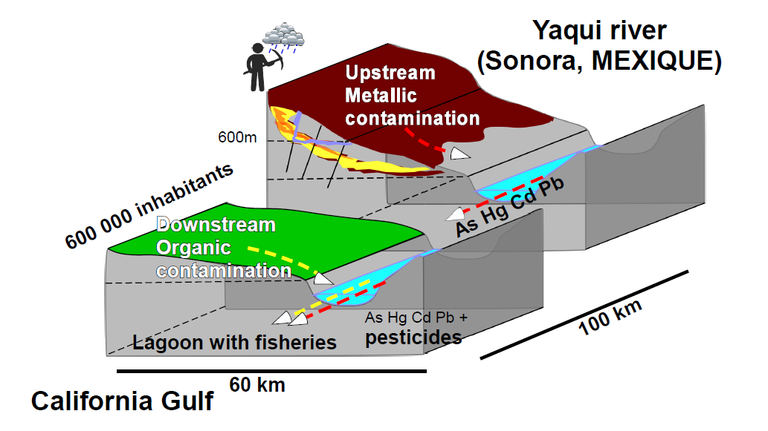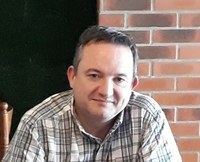Academy of Excellence "Space, Environment, Risk and Resilience"
Assessment and Dispersion of Contaminants in the Yaqui River (Sonora State, Mexico): Evaluation of Environmental Risks
Anthropogenic pollution of a hydrosystem in a mining and agriculture context: from chemical analyses to development of a new optical fiber-based sensor.

Academy 3 highlight
By measuring chemical pollution in water and sediments, the project contributes to the evaluation of natural and anthropogenic hazards related to pollution. The new sensor developed in the project to measure arsenic pollutants in water should significantly assist environmental monitoring.
The project
The Yaqui River (Sonora state, Mexico) is the longest and most important river in the “world belt of deserts” where the hydrographic system is highly sensitive to climatic changes. Anthropogenic activities along the river have induced high levels of contamination of the Yaqui waters due to metals and metalloids, either naturally present or added by mining activities, and pesticides related to agriculture. Chemical contaminants enter in the Yaqui hydrosystem and are transported by the river to a lagoon in the Gulf of California, and then to the Pacific Ocean. This contamination can have harmful effects on biodiversity and human health all along the river.
In the first part of the project, we sought to identify the major pollutants in the Yaqui hydrosystem. We found that the main inorganic pollution is carried by Fe, Mn, Zn, Cu, Cr, and As in the waters, by Cd and Hg in the sediments, and by Fe, Zn, and Cu in biota (clams in Tobari lagoon). We evaluated the mobility of each of these pollutants, focusing on their chemical forms both in water and sediments. One of the main forms of pollution in the water appears to be related to arsenic, in the form of arsenate species, a soluble and highly toxic form that can be transported over long distances. In contrast, the bioaccumulation of As in marine organisms is not very significant (low bioconcentration factors of 1.7-2.5). For the next step, we will examine the chemical forms of pollutants and the physico-chemical conditions in the river to estimate their transport in the Yaqui hydrosystem. Stable isotope measurements in water samples will also be performed to determine the origin of the nitrate contamination (e.g., agriculture).
In the second part of the project, we have developed an innovative sensor to detect and measure arsenic in rivers and ground water at trace concentrations (< 1 µg.L-1), in a continuous manner, and over large distances (> 100 m). This new sensor is based on optical fibers that are sensitive to arsenate species. The new Optical Fiber Sensor (OFS) will provide instantaneous measurements of As content in water, and hence will greatly assist pollution detection and monitoring.

The +
This project should result in the development of new innovative hydrogeochemical models for assessing pollutant transport while taking their chemical speciation and physicochemical conditions into account. In contrast to existing sensors, the new sensor we have developed is based on a new optical fiber sensor (OFS) that is sensitive to the arsenic content in water.
What’s next?
If we can obtain the Proof-of-Concept that our new optical fiber sensor can be used to monitor the arsenic pollution level in rivers and groundwater, we will validate these sensors by performing additional environmental studies. To this end, we will strengthen and expand our local, national (University of Lyon) and international collaborations (Mexico and India) and seek additional funding by applying for ANR grants.
Project information
|
Scientific domain
Earth sciences, Environmental chemistry
Theme Anthropogenic and Environmental hazards
|
Key words
Pollution
contamination
arsenic
hydrosystem
sediment
optical fiber sensors
|
|
Total budget
103 k€ including :
|
Students inolved
Béatriz Gonzalez (mexican PhD student, 2 months stay at Geoazur lab in 2018)
Quentin Deplano (Master 2 with B. Dussardier, INFINY lab)
|
| Partner laboratories
INPHYNI, Université Côte d’Azur
Institut Lumière Matière (ILM), Université Lyon 1
International collaborations
Instituto Mexicano de Technologia del Agua (IMTA), Mexico
Universidad Autonoma del Estato de Mexico (UAEM), Centro Interamericano de
Recursos del Agua, Mexico India, Indian Institute of Technology-Roorkee (IIT-R, India)
|
Project members
Renac Christophe,
Barats Aurélie,
Brigode Pierre,
Goudour Jean-Pierre,
Dussardier Bernard,
Ude Michèle,
Trzesien Stanislaw,
Hurel Charlotte,
Garrido-Hoyos Sofia Esperenza,
Vouagner Dominique
|
Project valorization
- M. Adier, A.-M. Jurdyc, D. Vouagner, B. Dussardier, Ch. Hurel, F. Goutaland, J.-Y. Michalon, "Surface-Enhanced Raman Scattering for arsenic detection and discrimination", 4th Int.Workshop on Metallic Nano-Objects (MNO 2018), Lyon; 5-7 Nov. 2018. (oral)
- M. Amraoui, M. Fombonne, M. Adier, A-M. Jurdyc, F. Bessueille, B. Champagnon, J. Margueritat, L. Bois, B. Dussardier, D.Vouagner, "Enhanced Raman scattering of amorphous matrices for fiber optic sensors", 3rd International Workshop on Metallic Nano-Objects (MNO 2016), Lyon, France, 2-4/11/2016 (poster)
- B. Dussardier, C. Hurel, M. Adier, D. Vouagner, A.-M. Jurdyc. "Recent progresses in optical detection and discrimination of pollutants in remote ground water and environment: a review." Int. Conf. Fib. Opt. & Photon. - PHOTONICS- 2018, Dec 2018, New Delhi, India. (Invited conference) Paper FA1-I1 ISBN : 978-9388653-41-1



















